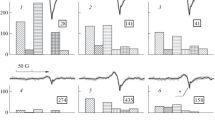Abstract
The effects of mono- and disubstituted phosphates on the photolysis reaction of reduced nicotinamide adenine dinucleotide (NADH) in a frozen (77 K) aqueous solution were studied by EPR. The dependence of the yield of the paramagnetic intermediates of the reaction, that is, the NADH+ cation radical and atomic hydrogen, on the concentration of phosphates was determined. The results were interpreted from the point of view of the basicity and electron acceptor properties of phosphates. Electron spectroscopy data revealed a significant acceleration of auto-oxidation and photoinduced oxidation of NADH under normal conditions (20°C, aqueous medium, phosphate buffer, pH 6.3). The rate of the dark reaction was directly proportional to the total concentration of orthophosphates and hydrophosphates and was insensitive to oxygen. On the basis of experiments with a nitroxyl trap, the conclusion was made that the reaction is not of a radical nature.




Similar content being viewed by others
REFERENCES
U. Eisner and J. Kuthan, Chem. Rev. 72, 1 (1972).
S. G. A. Alivisatos, F. Ungar, and G. Abraham, Nature 203, 973 (1964).
D. M. Stout and A. I. Meyers, Chem. Rev. 82, 223 (1982).
D. G. Nicholls and S. J. Ferguson, Bioenergetics (Academic, London, 2002).
T. Bugg, Introduction to Enzyme and Coenzyme Chemistry (Blackwell, Oxford, 2004).
S. Boulton, S. Kyle, and D. W. Durkacz, Br. J. Cancer 76, 845 (1997).
E. Ciesielska, K. Studzian, E. Zyner, at al., Cell. Mol. Biol. Lett. 5, 441 (2000).
M. Zhang, Y. Zhang, L. Zhengwen, et al., J. Environ. Manage. 232, 197 (2019).
P. P. Levin, O. N. Brzhevskaya, and O. S. Nedelina, Russ. Chem. Bull. 56 (7), 1325 (2007).
O. N. Brzhevskaya, E. N. Degtyarev, T. S. Zhuravleva, et al., Dokl. Biochem. Biophys. 420, 119 (2008).
O. S. Nedelina, O. N. Brzhevskaya, and E. N. Degtyarev, Dokl. Chem. 428 (2), 233 (2009).
A. A. Krasnovskii and G. P. Brin, Dokl. Akad. Nauk SSSR 158 (1),225 (1964).
A. V. Umrikhina, A. N. Luganskaya, and A. A. Krasnovskii, Dokl. Akad. Nauk SSSR 304 (6),1485 (1989).).
J. Jortner, M. Ottolenghi, J. Rabani, et al., J. Chem. Phys. 37, 2488 (1962).
O. N. Brzhevskaya, E. N. Degtyarev, P. P. Levin, et al., Dokl. Biochem. Biophys. 405, 395 (2008).
A. Anne, P. Hapiot, J. Moiroux, et al., J. Am. Chem. Soc. 114, 4694 (1992).
J. Zielonka, A. Marcinek, J. Adamus, et al., J. Phys. Chem. A 107 (46), 9860 (2003).
B. Czochralska and L. Lindquist, Chem. Phys. Lett. 101, 297 (1983).
J. Moiroux and P. Elving, J. Am. Chem. Soc. 108, 6533 (1980).
J. Gebicki, A. Marcinek, and J. Zielonka, Acc. Chem. Res. 37 (6), 379 (2004).
C. O. Schmakel, K. S. V. Santhanam, and P. J. Elving, J. Am. Chem. Soc. 97, 5083 (1975).
P. J. Elving, W.T. Bresnahan, J. Moiroux, et al., Bioelectrochem. Bioenerg. 9, 365 (1982).
J. Tornmalm, E. Sandberg, M. Rabasovic, et al., Sci. Rep. 9, 15070 (2019). https://doi.org/10.1038/s41598-019-51526-w
B. Czochralska, W. Kawczynski, D. Bartosz, et al., Biochim. Biophys. Acta, Gen. Subj. 801 (3), 403 (1984).
Funding
The work was carried out with budget funding (FANO project no. 0082-2014-0009, state registration no. AAAA-A17-117040610309-0).
Author information
Authors and Affiliations
Corresponding author
Ethics declarations
Conflict of interests. The authors declare that they have no conflicts of interest.
Statement on the welfare of humans or animals. This article does not contain any studies involving animals performed by any of the authors.
Additional information
Translated by E. Puchkov
Abbreviations: TEMPOL—4-hydroxy-2,2,6,6-tetramethylpiperidine-1-oxyl; Pi—mono- and disubstituted phosphates.
Rights and permissions
About this article
Cite this article
Brzevskaya, O.N., Degtyarev, E.N. & Kholuiskaya, S.N. The Role of Phosphate Anions in Autoinduced and Photoinduced Oxidation of NADH. BIOPHYSICS 66, 379–384 (2021). https://doi.org/10.1134/S0006350921030027
Received:
Revised:
Accepted:
Published:
Issue Date:
DOI: https://doi.org/10.1134/S0006350921030027



